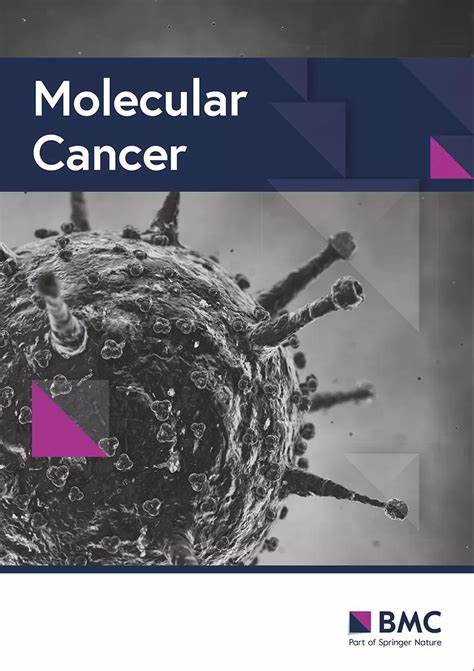M6A-Methylated circRAPGEF5 drives lung adenocarcinoma progression and metastasis via IGF2BP2/NUP160-mediated autophagy suppression
IF 33.9
1区 医学
Q1 BIOCHEMISTRY & MOLECULAR BIOLOGY
引用次数: 0
Abstract
Lung adenocarcinoma (LUAD), the predominant histological subtype of non-small cell lung cancer, demonstrates critical regulatory involvement of RNA-binding proteins (RBPs) and circular RNAs (circRNAs) in tumorigenic processes. Emerging evidence highlights the circRNA-autophagy regulatory axis as a crucial modulator of cancer progression. This study systematically investigates the functional interplay within the RBP-circRNA-autophagy network in LUAD pathogenesis. Employing RNA pull down, mass spectrometry and RNA immunoprecipitation facilitated the exploration of the circRAPGEF5 binding protein. M6A methylation RNA immunoprecipitation-PCR was utilized for m6A analysis. Immunofluorescence (IF) and fluorescence in situ hybridization (FISH) assays were conducted to ascertain the subcellular localization of target genes. Employing mRFP-GFP-LC3 fluorescent lentivirus labelling facilitated the monitoring of autophagy flow levels. Xenografts in mice were instrumental in affirming the role of circRAPGEF5. Through comprehensive molecular profiling, we identified elevated circRAPGEF5 expression in LUAD cells, which significantly suppressed autophagic flux while promoting malignant phenotypes including enhanced proliferation, migration, and invasion. Mechanistic investigations revealed that circRAPGEF5 directly interacts with the KH3-4 functional domain of Insulin-like Growth Factor 2 mRNA-Binding Protein 2 (IGF2BP2), an m6A reader protein. This interaction facilitated IGF2BP2-mediated stabilization of NUP160 mRNA, a nuclear pore complex component. Genetic ablation of NUP160 through RNA interference effectively restored autophagic activity, thereby attenuating the aggressive biological behaviors of LUAD cells. In vivo validation using xenograft models demonstrated that the circRAPGEF5/IGF2BP2/NUP160 signaling axis promotes tumor growth and metastatic dissemination through autophagy suppression. Our findings reveal a novel epigenetic regulatory mechanism wherein m6A-modified circRAPGEF5 orchestrates autophagy inhibition via IGF2BP2-dependent stabilization of NUP160 transcripts, ultimately driving LUAD progression and metastasis. These results establish the circRAPGEF5/IGF2BP2/NUP160 axis as a potential therapeutic target for LUAD intervention.m6a甲基化circRAPGEF5通过IGF2BP2/ nup160介导的自噬抑制驱动肺腺癌的进展和转移
肺腺癌(LUAD)是非小细胞肺癌的主要组织学亚型,在致瘤过程中,rna结合蛋白(rbp)和环状rna (circRNAs)具有关键的调控作用。新出现的证据强调circrna -自噬调节轴是癌症进展的关键调节剂。本研究系统探讨了rbp - circrna -自噬网络在LUAD发病机制中的功能相互作用。采用RNA拉下、质谱法和RNA免疫沉淀法对circRAPGEF5结合蛋白进行了探索。采用M6A甲基化RNA免疫沉淀- pcr技术进行M6A分析。免疫荧光(IF)和荧光原位杂交(FISH)检测确定靶基因的亚细胞定位。采用mRFP-GFP-LC3荧光慢病毒标记有助于监测自噬流水平。小鼠异种移植有助于确认circRAPGEF5的作用。通过全面的分子分析,我们发现circRAPGEF5在LUAD细胞中表达升高,显著抑制自噬通量,同时促进恶性表型,包括增强增殖、迁移和侵袭。机制研究表明,circRAPGEF5直接与胰岛素样生长因子2 mrna结合蛋白2 (IGF2BP2)的KH3-4功能域相互作用,IGF2BP2是一种m6A读取器蛋白。这种相互作用促进了igf2bp2介导的核孔复合物组分NUP160 mRNA的稳定。通过RNA干扰基因消融NUP160有效地恢复了自噬活性,从而减弱了LUAD细胞的侵袭性生物学行为。异种移植模型的体内验证表明,circRAPGEF5/IGF2BP2/NUP160信号轴通过抑制自噬促进肿瘤生长和转移性传播。我们的研究结果揭示了一种新的表观遗传调控机制,其中m6a修饰的circRAPGEF5通过igf2bp2依赖性NUP160转录物的稳定来协调自噬抑制,最终驱动LUAD的进展和转移。这些结果证实circRAPGEF5/IGF2BP2/NUP160轴是LUAD干预的潜在治疗靶点。
本文章由计算机程序翻译,如有差异,请以英文原文为准。
求助全文
约1分钟内获得全文
求助全文
来源期刊

Molecular Cancer
医学-生化与分子生物学
CiteScore
54.90
自引率
2.70%
发文量
224
审稿时长
2 months
期刊介绍:
Molecular Cancer is a platform that encourages the exchange of ideas and discoveries in the field of cancer research, particularly focusing on the molecular aspects. Our goal is to facilitate discussions and provide insights into various areas of cancer and related biomedical science. We welcome articles from basic, translational, and clinical research that contribute to the advancement of understanding, prevention, diagnosis, and treatment of cancer.
The scope of topics covered in Molecular Cancer is diverse and inclusive. These include, but are not limited to, cell and tumor biology, angiogenesis, utilizing animal models, understanding metastasis, exploring cancer antigens and the immune response, investigating cellular signaling and molecular biology, examining epidemiology, genetic and molecular profiling of cancer, identifying molecular targets, studying cancer stem cells, exploring DNA damage and repair mechanisms, analyzing cell cycle regulation, investigating apoptosis, exploring molecular virology, and evaluating vaccine and antibody-based cancer therapies.
Molecular Cancer serves as an important platform for sharing exciting discoveries in cancer-related research. It offers an unparalleled opportunity to communicate information to both specialists and the general public. The online presence of Molecular Cancer enables immediate publication of accepted articles and facilitates the presentation of large datasets and supplementary information. This ensures that new research is efficiently and rapidly disseminated to the scientific community.
 求助内容:
求助内容: 应助结果提醒方式:
应助结果提醒方式:


